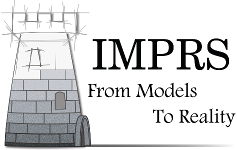Speaker
Description
The difficulty to reveal the atomic structure of bulk amorphous materials can be overcome using a thin film approach. The development of an amorphous 2D silica bilayer has recently allowed deriving the atomic positions by using scanning tunnelling microscopy (STM) [1], atomic force microscopy (AFM) [2] and transmission electron microscopy (TEM) [3].
In order to establish a general understanding of amorphous networks more structural characterization of glass-former materials, such as germanium oxide, must be done. Germania ultrathin films were grown on Ru(0001) and Pt(111) by physical vapor deposition and subsequent annealing in oxygen. The atomically flat films were characterized by combining intensity-voltage low energy electron diffraction (I/V-LEED) and ab initio density functional theory (DFT) analysis with high-resolution STM imaging.
The film-substrate interaction plays a decisive role in the film structure. On Ru(0001) a crystalline hexagonal monolayer film is obtained. Structural defects introduce ring-sizes that vary from the ideal six-membered rings. Highly resolved STM images allow classifying the different boundary structures according to their ring distribution. At higher coverage disordered phases are revealed, displaying similar features observed for silica bilayer films before. However, the connectivity rules seem to be different.
On Pt(111) many different phases can be identified after annealing in a narrow range of temperatures. Monolayers have shown either hexagonal or rectangular symmetry and also coexisting phases. The second layer grows atomically flat and amorphous, being an optimum model system to study and characterize glass properties.
References
[1] L. Lichtenstein, C. Büchner, B. Yang, S. Shaikhutdinov, M. Heyde, M. Sierka, R. Włodarczyk, J. Sauer, H.-J. Freund, Angew. Chem. Int. Ed. 2012 51, 404.
[2] E. I. Altman, J. Götzen, N. Samudrala, U. D. Schwarz, J. Phys. Chem. C, 2013 117, 26144.
[3] P. Y. Huang, S. Kurasch, A. Srivastava, V. Skakalova, J. Kotakoski, A. V. Krasheninnikov, R. Hovden, Q. Mao, J. C. Meyer, J. Smet, D. A. Muller, U. Kaiser. Nano Lett. 2012 12, 1081.

